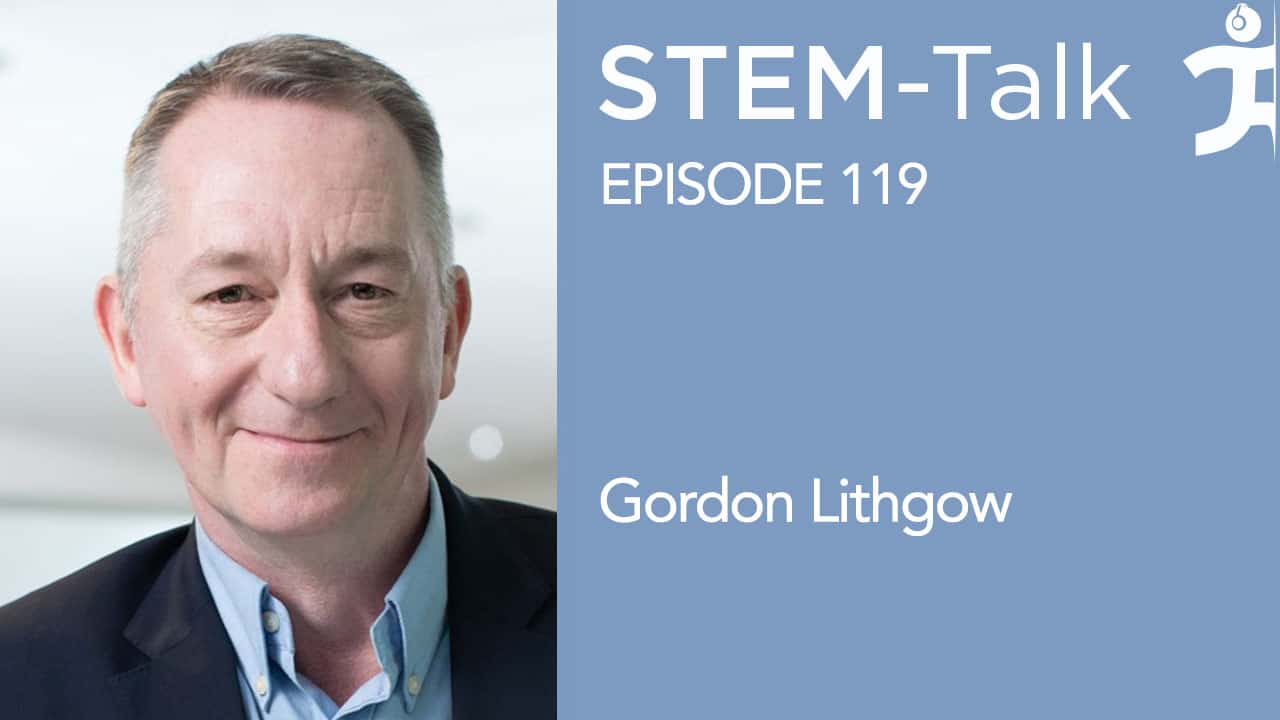STEM-Talk
Episode 119: Gordon Lithgow talks about the biology of aging and prolonging lifespan
// Feb 24, 2021

Episode 119: Gordon Lithgow talks about the biology of aging and prolonging lifespan
Our guest today is Dr. Gordon Lithgow, a professor and vice president of Academic Affairs at the Buck Institute in Novato, California. Gordon’s research focuses on uncovering genes and small molecules that prolong lifespan through enhanced molecular stability.
Because our conversation with Gordon was so extensive and fascinating, we have split his interview into two parts. In today’s part one of the interview, we talk to Gordon about his background and early studies as well as his fascination with C elegans, a microscopic worm that Gordon and other geneticists study and often use for their research. We particularly talk in depth about two of Gordon’s studies involving C elgans: one that looked at the role that protein homeostasis plays in aging; and another study that found vitamin D3 improves protein homeostasis and slows aging.
A native of Scotland, Gordon researched the biology of aging at the University of Manchester in England before moving to the Buck Institute in 2000. Gordon is married to Dr. Julie Andersen, who was our guest on episodes 117 and 118 and who also is a researcher at the Buck Institute.
In part two of our interview with Gordon, we talk to him about a recent study of his that found the naturally occurring metabolite alpha-ketoglutarate reduces inflammatory signaling as well as chronic inflammation. The study has generated quite a bit of buzz because it suggests there’s a readily available metabolite that may have positive effects on lifespan and health span. As a result, Ken and Dawn have been getting numerous questions from listeners about alpha-ketoglutarate and Gordon’s recent study that ran in Cell Metabolism, which Gordon talks about in depth in part two.
Show notes:
00:03:59 Dawn opens the interview asking Gordon about growing up in a steelwork town outside of Glasgow, Scotland.
00:04:22 Dawn asks Gordon what he was like as a kid.
00:05:07 Dawn asks Gordon how a young boy who had aspirations of becoming a professional rugby or soccer player suddenly becomes passionate about birdwatching.
00:07:07 Gordon talks about how he went to the University of Strathclyde after high school and how he was the first in his family to attend college.
00:07:48 Dawn asks Gordon why he shifted his academic interests from microbiology to genetic engineering.
00:09:05 Ken asks what led Gordon to attend the University of Glasgow for his doctorate after getting a degree in microbiology.
00:10:04 Ken asks why Gordon went to Switzerland after receiving his doctorate.
00:10:57 Ken asks what prompted Gordon to head to Boulder, Colorado, and why he became so interested in the biology of aging.
00:12:57 Dawn mentions that while Gordon was working in Tom Johnson’s lab during his post-doc, Gordon made what Tom referred to as an amazing discovery. Gordon had found that a single heat shock to worms increased their lifespan by 15 percent. Dawn asks Gordon to talk about this discovery as well as his paper that ran in PNAS.
00:15:46 Ken mentions that because of Gordon’s discovery, many people have developed an interest in sauna.
00:16:57 Dawn mentions that a number of years after discovering that heat shocking increased the lifespan of worms, Gordon followed up on that study and demonstrated that giving the worms repeated mild hormetic heat treatments increased their lifespan even more. Dawn goes on to ask if, since this follow-up study, Gordon has a better understanding of hormesis mechanisms at the cellular and molecular level and how that might relate to the prevention and treatment of different diseases.
00:18:02 Dawn mentions that Julie Anderson, Gordon’s wife, was interviewed for STEM-Talk episodes 117 and 118. Dawn goes on to say that when she asked Julie how she and Gordon met, Julie said, “I was having a transatlantic relationship with Gordon and we met because we’re nerds.” Dawn asks if Gordon would like to respond to this assertion that he’s a nerd, and whether it is true that he ended up at the Buck Institute on Julie’s coattails.
00:20:40 Dawn asks Gordon what are the main questions which have motivated his research.
00:23:07 Dawn mentions that in Gordon’s work he screens natural compounds like vitamins and minerals to determine if they have the potential to affect lifespan. Gordon does this by studying C elegans, tiny nematode worms that are found in rotting fruit and on the backs of snails. Dawn asks why Gordon and other geneticists are so found of using C elegans in their research.
00:25:54 Ken mentions that a lot of Gordon’s recent research with C elegans has looked at the role that protein homeostasis plays in aging. Ken asks Gordon to give an overview of the role that proteins play in determining lifespan.
00:29:07 Ken asks Gordon about his paper in Aging Cell which indicated that the accumulation of insoluble proteins with diverse functions could be a general feature of aging. The paper also showed that many hundreds, if not thousands of proteins, undergo conformational change during aging and come out of solution. Gordon explains what this conformational change is and what it means to come out of solution.
00:29:58 Dawn mentions that, as Gordon has already pointed out, we know that proteins sustain lots of damage in the normal course of metabolism. Dawn asks Gordon to discuss how he and other researchers are trying to better understand the mechanisms of normal aging that are likely to accelerate age-related pathologies and diseases.
00:32:16 Dawn asks why Gordon started looking into how excessive dietary iron affects protein homeostasis in worms.
00:35:11 Dawn asks Gordon for his thoughts on whether or not his findings on the effects of iron in worms may have some physiological relevance for humans.
00:35:42 Ken, in light of the effects iron has on health asks Gordon what effects other metals could potentially have on protein homeostasis and overall physiology.
00:37:02 Dawn shifts to talking about Gordon’s research into vitamin D. Dawn mentions that in Gordon’s interview with Rhonda Patrick, who back in 2016 was one of STEM-Talk’s first guests, appearing in episode 3, Gordon told Rhonda a story about how someone came to the office and suggested studying vitamin D, to which Gordon said “No way. There’s nothing new to learn about vitamin D.” Dawn asks what changed his mind.
00:40:55 Ken mentions that in Gordon’s study, which appeared in Cell Reports, he observed that vitamin D3 improves protein homeostasis and slows aging. Ken states that the obvious takeaway is that it is important to maintain appropriate vitamin D serum levels. He asks if Gordon was able to determine what the appropriate level is for humans.
00:44:43 Dawn asks if Gordon has looked at whether vitamin D deficiency in older adults might explain why seniors and nursing-home residents have an elevated risk when it comes to COVID-19.
00:47:35 Ken shifts to asking Gordon about some work he did a few years ago with two other labs where they dug into the issue of experimental reproducibility. Ken asks Gordon to give a brief background of this research.
00:51:08 Ken closes part one of our interview with Gordon by mentioning that reproducibility is considered a cornerstone of experimental science. Ken asks what Gordon thinks are the primary drivers of irreproducibility in science and what Gordon thinks can be done better.
Links:






